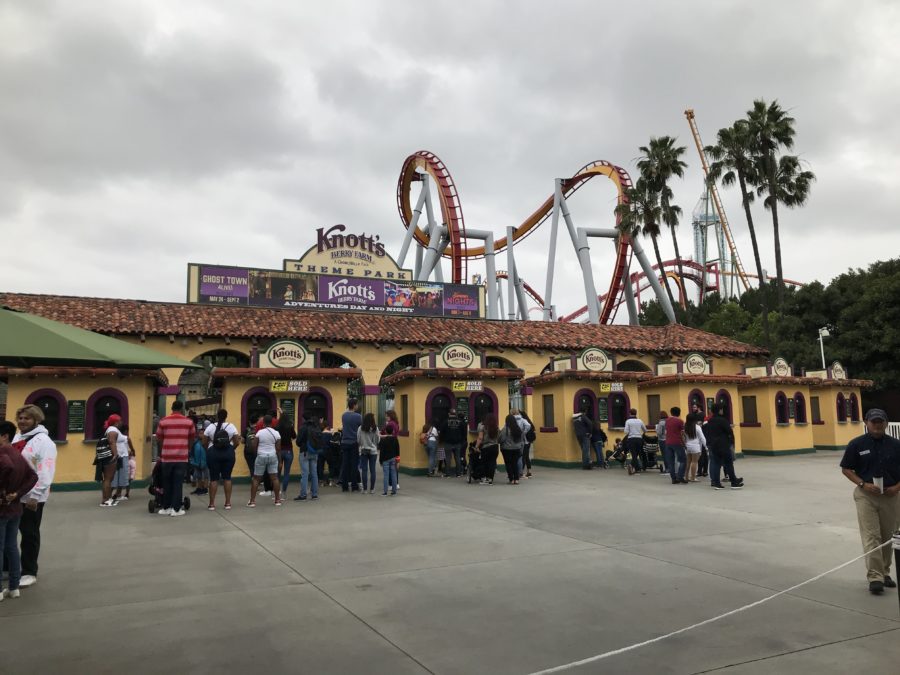
In our new travel series, our resident thirty-something-going-on-five year old takes us on an adventure around the world to the best theme parks. The ones that even after we lose that childhood awe and wonder, still get the heart racing; gleefully removing us from the mundane existence that is adulthood. Along the way you’ll be taken to internationally beloved classics and some places you’ve probably never heard of. But each is a destination every theme park fanatic should have on their bucket list.
In 2020, the first park we’re covering in this series will be turning 100 years old, making it “California’s Oldest Theme Park”, as their slogan will tell you. Though this is a bit misleading as it actually started life as a Berry Farm. So how did Knott’s Berry Farm go from Berry Farm to one of the world’s greatest theme parks? Read on to find out.
Park History
The story of how Knott’s Berry Farm got its start is one of the great examples of modern American ingenuity; a true case of building as needs arose, rather than being prepared with some grand plan in motion. It goes back 100 years, when Walter Knott and his family set up a Berry Farm in Northwest Orange County, just 15 minutes from the future home of Disneyland. It all started with a roadside stand along State Route 39, where they sold berries, berry preserves, and pies. Twelve years later, they became the first place in the world you could buy Boysenberries. The vines still scatter the park to this day and Knott’s continue to produce over 1 million pounds of boysenberry products every year. Interestingly though, it’s now New Zealand that sits as the world’s largest producer and exporter of the berry, a unique cross of four other berries, which Walter Knott was the first to commercially cultivate.
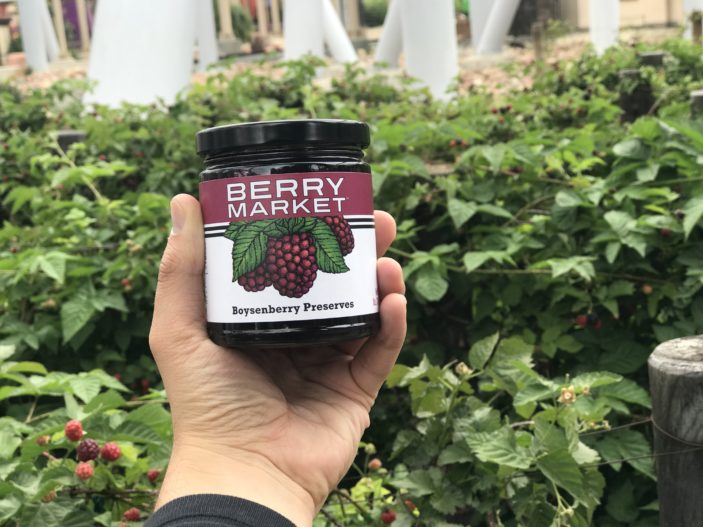
This rise in popularity, and the introduction of Boysenberry Jams made by Cordelia Knott, led to the opening in 1934 of Mrs. Knott’s Chicken Dinner Restaurant, where she would serve her homemade biscuits, fried chicken dinners and Boysenberry pies. Lines got so long, and demand grew so heavy for the meals, that the Knott’s family started building other shops and attractions to keep people entertained as they waited – sometimes hours – for their seats. In 1940, work began on the first major attraction open to help entertain guests – a Ghost Town, built with a mix of authentic and re-created buildings from the 1800s, with the town being slowly but regularly expanded over the following 12 years. The Butterfield Stagecoach – an authentic 1800s stagecoach – was introduced in 1949. Then on January 12th, 1952, the Calico Railroad opened, which gave guests an authentic steam railroad experience, and took guests around the farm in about 10 minutes.
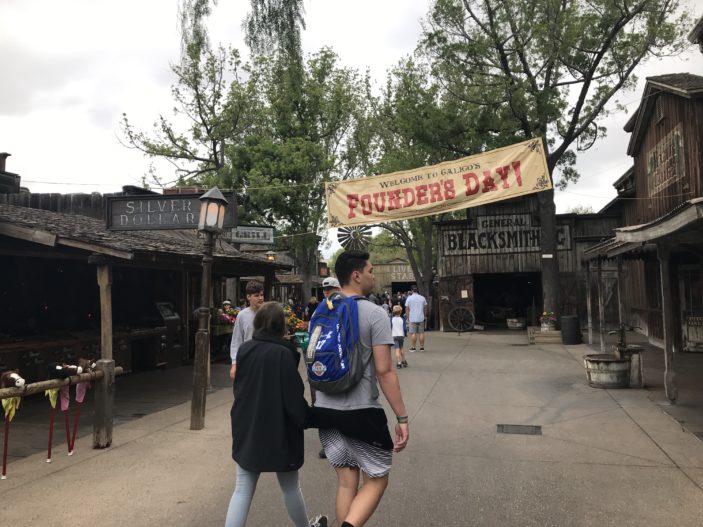
The Ghost Town, Stagecoach and the Calico Railroad (seen below) remains in operation to this day, with some buildings genuine to the 1800s, including the Blacksmith Store, which remains a functional Blacksmith for the park. There are also unique structures like the Bottle House, which was built in 1944 out of 3,000 empty wine and whiskey bottles, inspired by similar structures found in some early-day mining towns. A Music Hall opened the following year showcasing mechanical music players, that included automaton birds that could whistle, which preceded the whistling birds at The Enchanted Tiki Room that opened at Disneyland in 1963, and the evolution of Audio-Animatronics® by Disney’s Imagineers. The influence isn’t mentioned in the brilliant new Disney+ documentary series The Imagineering Story, but Walt was said to be a regular visitor at the farm, so it’s hard to imagine the idea didn’t originate here.
There are actors that are spread around the Ghost Town, who you can interact with, and it really does have give it all a bit of a Westworld feel in the modern context – which will be fun for fans of that series. Just don’t take that description too literally – you’re definitely not allowed to do what you want in this family friendly environment. But they do want to take you back in time, and the Ghost Town itself is particularly inspired – both in name and practice – by the Calico Ghost Town, which you may have popped into if you’ve ever driven from Los Angeles to Las Vegas, sitting en route.
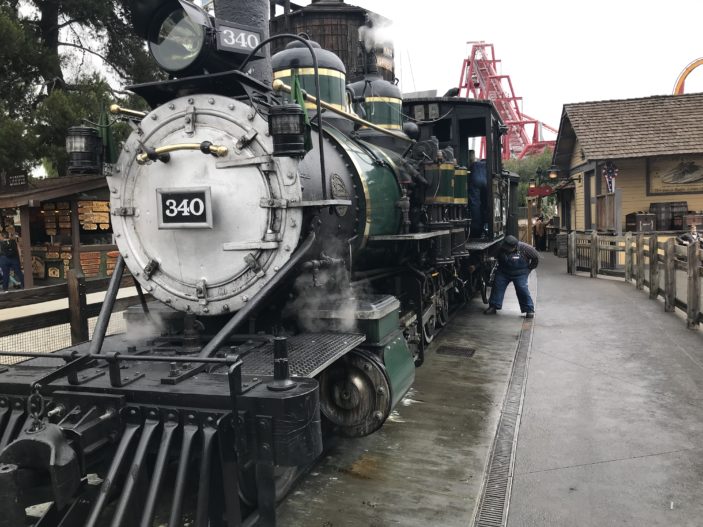
The first ride to be introduced to the farm was in 1955, when Bud Hurlbut convinced Knott to install what is now one of the world’s oldest working Dentzel Carousels. To this day it continues to revolve around an antique Band Organ, and has been operating for over 100 years (it itself coming from Hershey Park in Pennsylvania). It seemed to fit the theme for Knott’s, which was all about celebrating the heritage of America at their farm. But at the end of the day, this was all to accompany a fried chicken and boysenberry restaurant, which also remains in operation and is now accessible separate to park admission.
In fact, park admission didn’t start until 1968, when it cost 25 cents to enter, and you’d buy separate admission tickets for the rides – which at that point was the merry-go-round and a groundbreaking Calico Mine Ride, which opened in 1960 and was the biggest dark ride ever made at the time. Bud Hurlbut built and engineered this one himself, as he did the world’s first indoor “themed” log ride, the Timber Mountain Log Ride, featuring a number of animatronics, which opened in 1969 and can be seen as the precursor to a ride like Splash Mountain at Disneyland (just as the Calico Mine Ride provided inspiration for rides like Pirates of the Carribean at the same park).
And since then they haven’t stopped introducing new rides and attractions, growing into four distinct “lands”. They brought in Snoopy and Friends to be the park’s sole IP in 1983 for the kid’s land “Camp Snoopy”, and now have some 10 rollercoasters in operation, making this a destination for families and thrill-seekers alike.
So, what makes this park so special?
Sitting just 15 minutes from Disneyland, for Californians this is a park that has always sat in its shadow, even if they were originating some of the themes and technologies at the time. And its push in more recent decades towards thrill rides came at the risk of comparisons to the superior Six Flags Magic Mountain, which is about 90 kilometers away, and has the world record for most roller coasters in a single park.
So why does this park get to open up our new series, when its so often been seen as the underdog in a competitive, IP focused market that also has parks like Universal Studios just up the road?
It’s because this is the park that started the theme park story in the region – and there is no park quite like it anywhere else around the world. A theme park that started as a ghost town out the back of a fried chicken restaurant and berry farm? That’s a story you couldn’t make up if you tried. The result is a park that gives you an experience that still sits very much in the heart of what the Knott’s family intended, while throwing in no less than 40 attractions and 10 roller coasters, attracting more than 4 million visitors a year and ensuring there is something for everyone. Even a plate of fried chicken or a slice of Boysenberry pie, still using Mrs. Knott’s original recipe.
Newest attraction(s)
There are two rides you’d consider the “newest attractions” at Knott’s Berry Farm. The first is the Calico River Rapids, which opened in May of this year, and is a re-imagining of the “Bigfoot Rapids” that had sat in the same spot since 1987. As the name suggests, it’s a river rapids ride that now features some 20 new animatronics and tells a story of two of the characters that now feature in the park’s Ghost Town, Potts and Colter, taking place in the early days of Knott’s Ghost Town.
But the most recent completely new attraction is the rollercoaster HangTime (pictured below), which is the only ride of its kind in California (a feat they’d be proud to have beaten Six Flags Magic Mountain to). The coaster opened last year, in what was the park’s first major coaster in years, and is one of only 14 Dive Coasters in the world, featuring one of the steepest drops of any coaster in the world, and certainly the steepest in the State, at 96 degrees. The basic concept of the dive coaster is that you slowly climb to the peak, before you hang out over the edge and dive without warning at a vertical angle – sometimes so far they need to take you underground (as in the Yukon Striker at Canada’s Wonderland, just outside of Toronto, a park with the same owner – Cedar Fair).
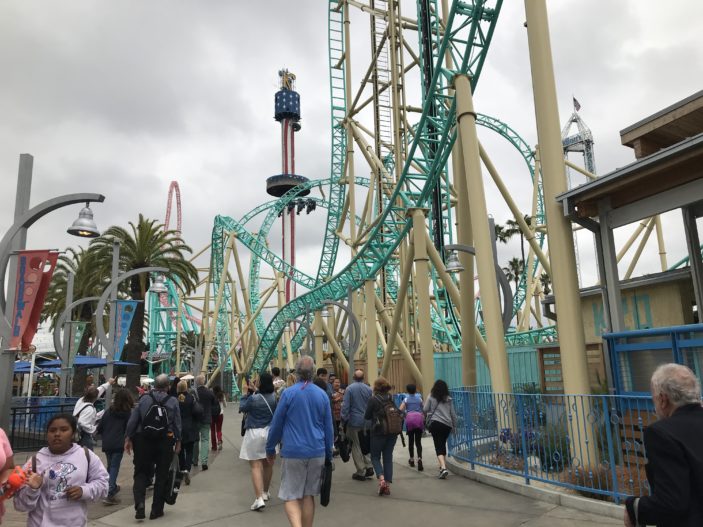
But the dive isn’t everything – HangTime goes on to feature 5 inversions – a Negative-G Stall Loop, Corkscrew, Cutback, and a Cobra Roll – and reach speeds of 92 kilometres per hour. It’s a truly thrilling ride, with the moment you hang over the edge being truly terrifying. But the ability for the ride to continue surprising you after that moment is really what makes it something special. The only downside to the ride is that it replaced a favourite at the park, the Boomerang – but this is often the way with theme parks. Something needs to be knocked down to pave the way for something even better,
The Best Attraction(s)
The roller coaster Xcelerator is a hell of a good time, and even though it launched in 2002, still gives HangTime a run for its money in terms of thrills. Riders accelerate from 0 to 132 km/h in 2.3 seconds and climb 20 stories into the air – before taking a thrilling turn over a hill and continuing the ride on the other side at equally breathtaking speeds. I definitely got my biggest thrill of the day on this one.
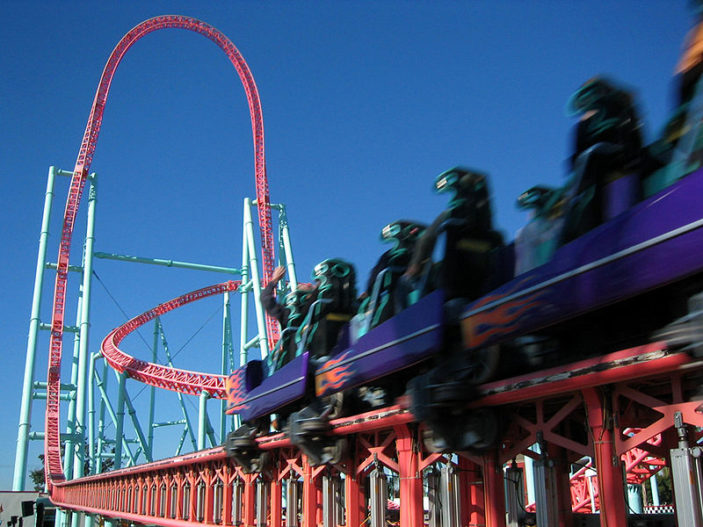
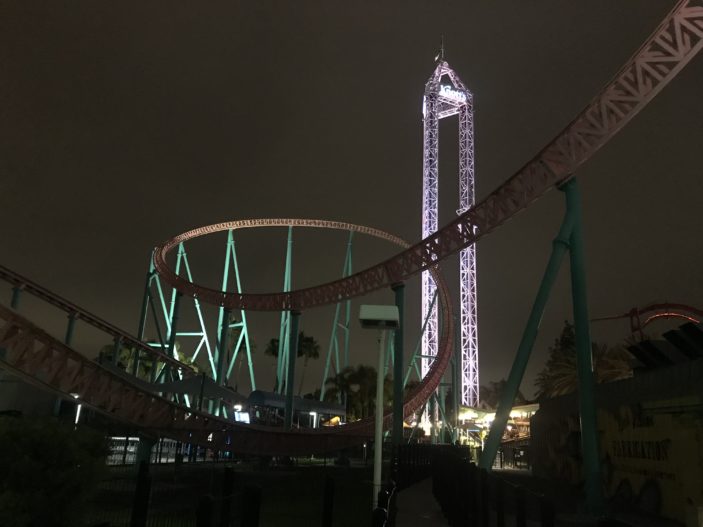
Given the park’s history though – and particularly if you don’t have a penchant for thrills – there’s still nothing quite like the Calico Mine Ride, which was built in 1960 by Wendell “Bud” Hurlbut. You ride it for its history, while the age of the ride gives you the added thrill of not being sure if the whole thing is going to burn to the ground while you ride it. Given its refurbishments in 2014, I can only assume that’s deliberate – right?
In so many ways the ride was an experiment – never before had there been a true “dark” amusement ride. Guests are shuttled into a train with multiple mine carts – which each cart holding a good deal of guests – meaning they could traffic a large number of passengers per hour. Given its ingenuity, and the fact that it was a standalone attraction with its own admission price, it was an expensive risk, but one that paid itself off quickly. And its success is the reason rides like it took off shortly thereafter – not the least of which, it led the way ahead of Disneyland’s advancement of the technologies through rides like Pirates of the Carribean, which opened 7 years later.
What’s Coming in 2020
The lackluster attraction Voyage To The Iron Reef – a 4D interactive dark ride – will be closing after less than 5 years in a couple of weeks, to make way for a nostalgic new ride Knott’s Bear-y Tales: Return to the Fair, a sequel to the ride that used the sit in the same spot – Knott’s Bear-y Tales – from 1975 to 1986. And between 1987 and 1997 a walk through attraction in Camp Snoopy featured some of the characters that used to sit on the dark ride, so even though who never rode the original ride may remember its characters.
The ride will still be a 4D interactive experience, and promises to feature “several classic show scenes that are reminiscent of the original ride”. It’s all part of the park’s 100th Anniversary celebrations set to take place in 2020, with the ride planning to open alongside the official launch of those celebrations on 15th May 2020. The ride will be accompanied by “festive park décor, themed food items, unique entertainment, exclusive merchandise and special surprises along the way, all paying homage to the nostalgia that surrounds the historic theme park”, that will run until 30th August.
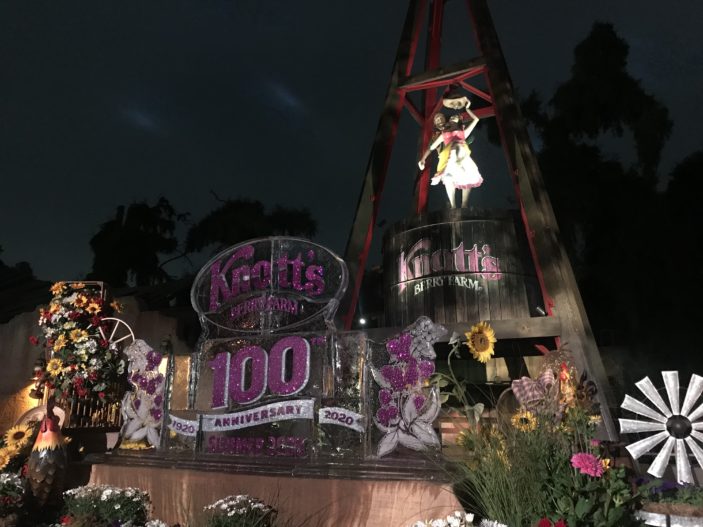
Other park highlights
Four “lands” have been incorporated across the park’s 57 acres – Ghost Town, Camp Snoopy (which enjoyed a refurbishment in 2014), Fiesta Village and The Boardwalk. 10 coasters and 40 attractions sit across these lands, with relative newer rides like the Silver Bullet (2004) alongside older rides like the Jaguar! (1995) – which was one of the first roller coasters I ever went on, and is designed with younger riders in mind – and Montezumas Revenge (1978), which was the first flywheel-launched roller coaster in the world, and is the last ride of its kind still operating in the United States. It’s remains a real fun time (and rarely has a line).
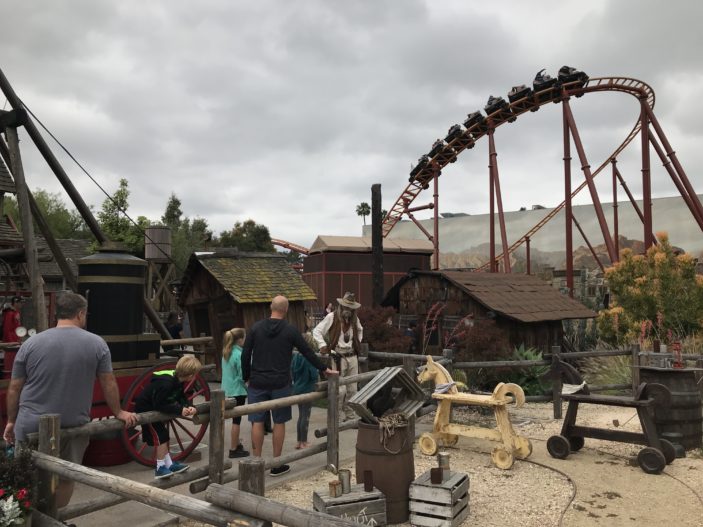
You’ll also find the Pony Express, the only Motorbike Roller Coaster in California (pictured above as part of Ghost Town, having opened in 2008). The point is, there’s something substantial to be said about just about every ride and nook and cranny of this park. Take what might have otherwise been a run of the mill fountain (pictured below), which you’ll find in Charleston Circle. This was actually the fountain used in the Fox movies The Towering Inferno and Hello Dolly!, which was subsequently featured in the Disney Pixar film Wall-E.
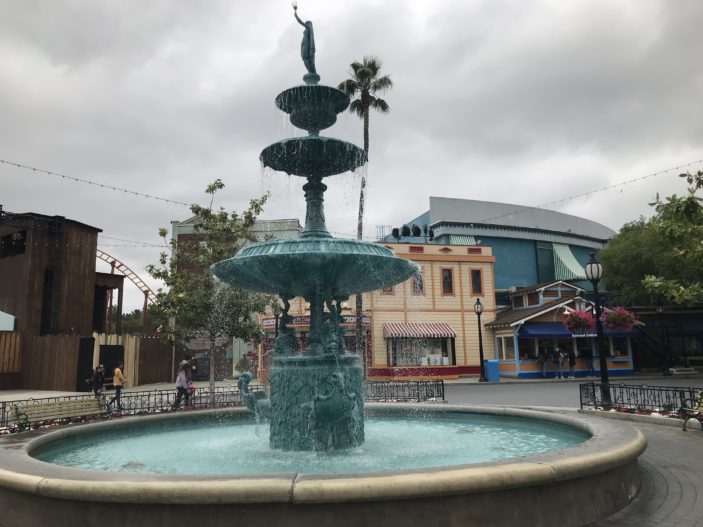
If you’re in town in October, also look out for Knott’s Scary Farm, which has become one of the most popular Halloween events in the State, having been running annually since 1973 through the entire month. In fact, it’s so popular and profitable for the park that they make half of their annual revenue during the period. There’s also a water park next door to the park, Knott’s Soak City, which is accessible with a separate admission.
How to get there
Knott’s Berry Farm is located 35km southeast of Downtown Los Angeles, in Buena Park – which you’ll hit about 10-15 minutes before you arrive at Disneyland. From Australia, getting to Los Angeles is possible through a variety of airlines, with direct flights from Sydney, Brisbane and Melbourne to LAX available with Qantas, Virgin Australia, American Airlines, Delta and United.
Look into renting a limo to get to locations like Knott’s at https://www.limofind.com/.
Get more details about the park and its 2020 celebrations at knotts.com
All photos by the author, unless otherwise credited. The author visited as a guest of the park.
